The Nexus 6 Review
by Brandon Chester on November 12, 2014 1:00 PM ESTDisplay
The display is one of the most important aspects of a smartphone, as it is the part of the device that the user will interact with most. We've seen tremendous improvement in smartphone displays as they have become more and more commonplace within society. The first area of improvement was resolution, which made sense with text being a necessary part of essentially every smartphone application. As displays have gotten to the point where there is little benefit to further increasing pixel density, we have also seen a push for greater color accuracy and image rendition. On the Android side of the market, Google was one of the first companies to start taking color accuracy seriously, and the Nexus 7 and Nexus 5 had some of the best calibrated displays of all Android devices.
The Nexus 6 sports a 5.96" AMOLED display with a resolution of 2560x1440. Given Google's work to provide accurate color calibration on the Nexus 5, and the massive improvements that we've seen in the calibration of AMOLED displays over the course the past year, I was very excited to take a look at the display on the Nexus 6. However, as someone who typically uses the very well calibrated iPhone 6 and Nexus 5 in daily use, I immediately noticed that the Nexus 6 produced a punchier image than I was used to seeing in the applications I use frequently.
To take a look at the characteristics of the Nexus 6's display we turn to SpectraCal's CalMAN 5 software and an X-Rite i1 Pro 2 spectrophotometer for accurate measurements of the display's color. As always, we target the sRGB gamut which is currently the standard for photos on the web and video content.
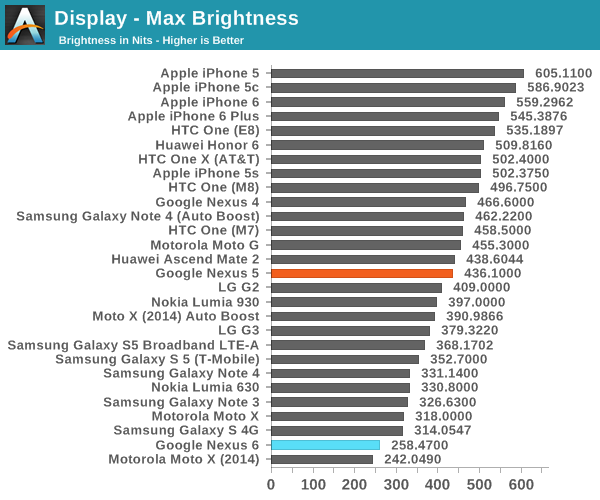
Contrast and black levels on the Nexus 6 are as incredible as ever. Brightness is definitely on the low side though. Testing was performed with both the manual brightness settings, and with Adaptive Brightness enabled and a bright LED aimed at the light sensor. In both cases the maximum brightness was the same, there's no higher brightness exposed when using the automatic brightness settings like there is for the Galaxy Note 4. What's interesting to note is that the brightness is similar to that of the 2014 Moto X, another recently released Motorola device that sports an AMOLED panel. However, even Moto X has an auto boost mode which pushes it up to 390nits. The overall similarity between the panel in the Moto X and the panel in the Nexus 6 persists throughout our other tests.
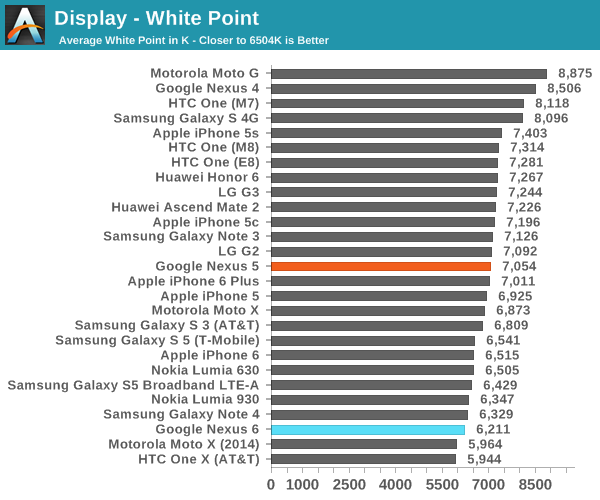
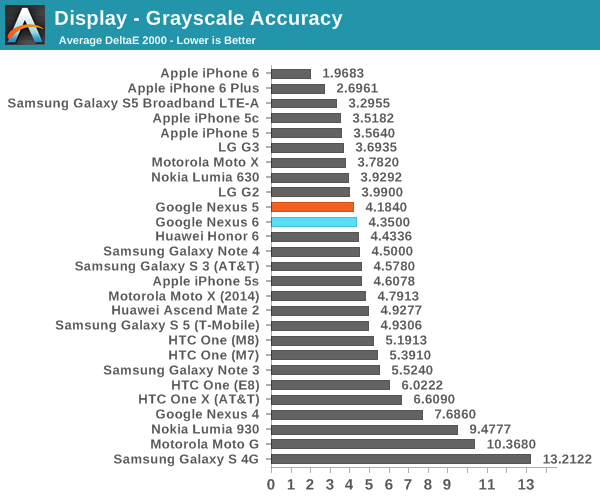
The Nexus 6 is slightly more red than our target for white point, though not to the extent of the 2014 Moto X. This contrasts with the IPS panel in the Nexus 5 which was too blue. In the greyscale we see that the luminance is comprised more of red and green than of blue. This translates to greyscale performance that is nothing exceptional, but not noticably worse than the Nexus 5, and still significantly improved compared to AMOLED panels from not long ago like the display in the Galaxy Note 3.
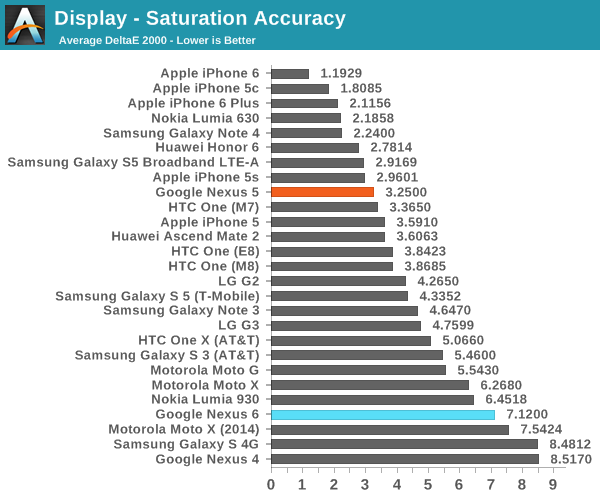
In our saturation sweep test, the Nexus 6 performs rather poorly. Unlike Samsung's phones which have several display modes with one of them targeting sRGB, the Nexus 6 has only one display setting and it significantly overshoots the sRGB gamut. This does a good job at creating showroom appeal but is not helpful in accurately displaying the color in photos and videos. This is especially disappointing because the Nexus 5 was well calibrated to sRGB and performed much better in this test.
The poor performance in the saturation sweep translates to equally poor performance on the ColorChecker test. The expanded gamut and saturation compression makes it effectively impossible for this display to render any sRGB content accurately. The greyscale performance helps to bring down the overall average, but the large errors with color mixtures prevent any sort of accurate image rendition.
I was highly disappointed by these results. Like I said earlier, we've seen great improvements in the quality of AMOLED displays as of late, and Google took color calibration very seriously with the Nexus 5. The Nexus 6 shows significant regression in color accuracy from the Nexus 5, and the maximum brightness is much lower. It should also be noted that despite its higher resolution, its larger size means that compared to the Nexus 5 the pixel density only increases 12% from 441 PPI to 493 PPI. The use of a PenTile RGBG subpixel layout also means that there is actually an overall decrease in subpixel density.
Overall, the Nexus 6 display is quite poor relative to the displays on other smartphones like the Galaxy Note 4, iPhone 6, and HTC One (M7). It's also a definite regression from the display on the Nexus 5, which is concerning given the fact that the Nexus 6 is $300 more expensive. It has been speculated that Motorola is unable to source the latest generation of panels from Samsung Display, which would explain why many of the panel characteristics are similar to previous generation AMOLED panels in the Note 3 and Galaxy S4. Although the efficiency of AMOLED displays when displaying black helps to reduce power usage with features like Ambient Display which wakes up the phone when notifications arrive or it is picked up, I don't believe it's worth the trade-off if it involves such heavy sacrifices in color accuracy and brightness.


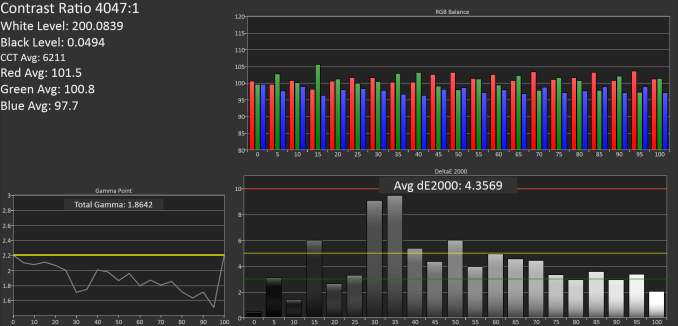
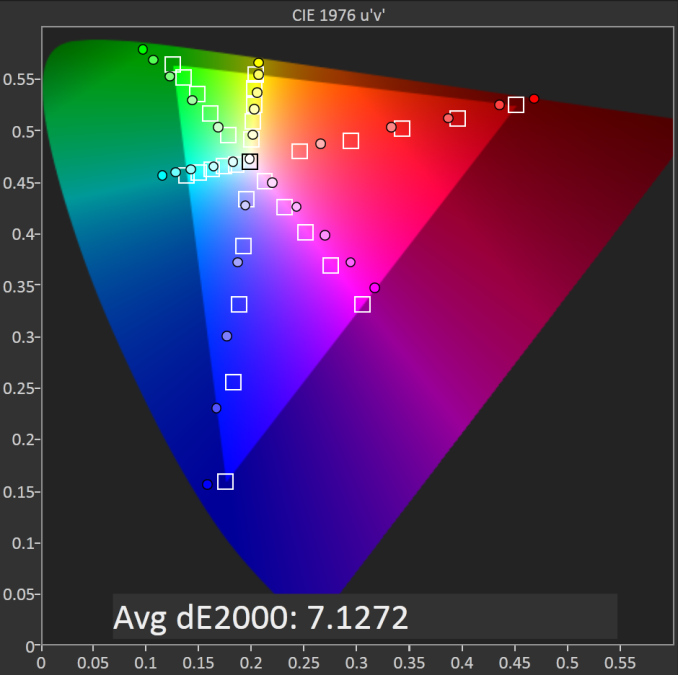









136 Comments
View All Comments
Spunjji - Friday, November 14, 2014 - link
A better battery and camera in this would persuade me to upgrade in a heartbeat. I only hope that if they eventually replace the 5 with an equivalently-sized phone (5 2015?) they keep the wonderful screen.niva - Friday, November 21, 2014 - link
Yes, I'm hoping for a Nexus 5 refresh with all the new fluff like the chip/ram/camera and battery. I think the Nexus 5 design and screen are perfect. My wife has a Nexus 5 and I'm still on my Gnex. Was hoping to get the 6 but with the size and price I'm going to wait some more. Roll on the Enyxos 810 phones and I might get whatever runs pure Android.PS. I cannot stand Touchwiz/Sense and whatever LG and Sony are doing on their "flagships." Thankfully Motorola has mostly stock interface.
techconc - Friday, November 14, 2014 - link
LOL! Good luck with that. The Nexus 5 is known to have weak radio signals and overall poor cell and WIFI reception. Not exactly the best choice and it's not really competitive with recent devices.owan - Wednesday, November 12, 2014 - link
Because Google isn't a charity?synaesthetic - Thursday, November 27, 2014 - link
Google would have been better off making another "almost-flagship" at the $350 price point. I've been using Nexus devices since the Nexus S, but now... no, it's just too damn big and too damn expensive.algarblandom - Wednesday, November 12, 2014 - link
Having a Nexus 5, I see very few reasons to upgrade to this, unless you stronly like phablets. But in almost every area (battery life, camera, cpu performance, software..) it is almost a draw.anactoraaron - Wednesday, November 12, 2014 - link
I'm curious, you've listed the nexus 5 as running lollipop in the first comparison chart... is it running the dev preview or the official release (that's MIA to the public)? Also, are the rest of the charts where the nexus 5 is listed results from the original kitkat release or from a lollipop build? I'm asking because the camera experience was greatly improved with the dev preview for the 5.Also I was worried about the display with moto making the 6... looks like that was justified. The 6 needs a price drop to sell IMO. As you state, the Note 4 is so much better on battery life and display and can be had for only $100 more (if you have T-Mobile anyway).
anactoraaron - Wednesday, November 12, 2014 - link
I'm just saying it's confusing to show the 5 as having Lollipop but show the original test results from 4.4.DILLIGAFF - Wednesday, November 12, 2014 - link
amenAT are comparing apples to oranges in charts and then writing words about pumpkins. i think the methodology error is that you (you as in AT staff) combined a performance review of a new os and a performance review of a new piece of hardware one too many times when it comes to phones. it worked for a while but this release its clear as mud... the outcome is that this review basically sitting in a vacuum- nothing to compare to objectively, so now your subjective comments are worth more than the benchmarks, which at this point are arbitrary. it's like benchmarking a new motherboard and using a just-released retail windows 8.1 on the tests of that new board, while the other motherboards in the benchmark charts are run on an windows 7 or windows 8. except there is no label in the charts to indicate which device is running what os. i bet if you did this with pc benchmarks people would flame you to death.
while i understand your position with a new device and os combination making things more difficult to test, you make things more confusing by labeling the spec table for nexus5 as having os lolipop...yet the bench charts you show are for nexus 5 running the original release of kitkat.
imho to address this issue in this specific review you should run additional benches for nexus 5 on lollipop (google released the production images on their dev site today) and add them to this review's charts. that way, the label in the spec table correlates to what i see in the charts. and that way, we have at least 2 lolipop devices to visually compare to each other in terms of performance. add the moto G and X performance numbers running lolipop for extra brownie points.
i am not trying to attack the writer/editor, i love this site, just asking for additional data so i can see an apples to apples performance comparison of the new device to an older device running same os release. maybe i am just too traditional....
Brandon Chester - Wednesday, November 12, 2014 - link
I put Lollipop because Google will be rolling it out soon, but the results from all the tests are the original N5 results in Bench. I had been using the Lollipop preview on the N5 for an upcoming Android L review, which is how I determined that the N6 has regressions in UI performance. However, I disagree with the idea that there are any improvements to the camera on the N5 going from 4.4 to 5.0. I didn't notice any, and the software isn't going to save the camera system from just being inherently not very good.